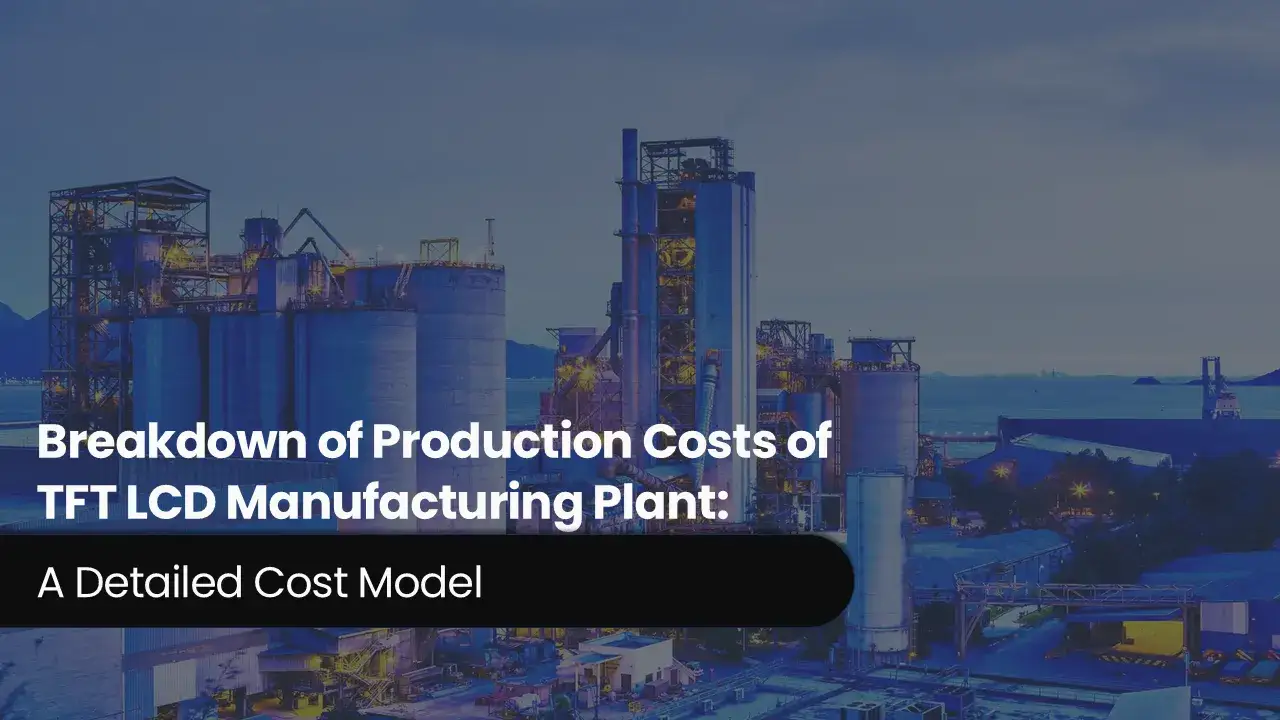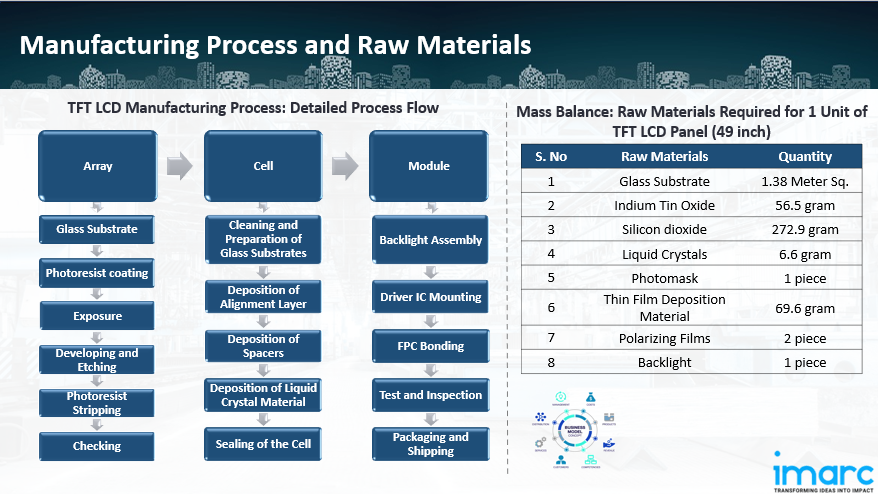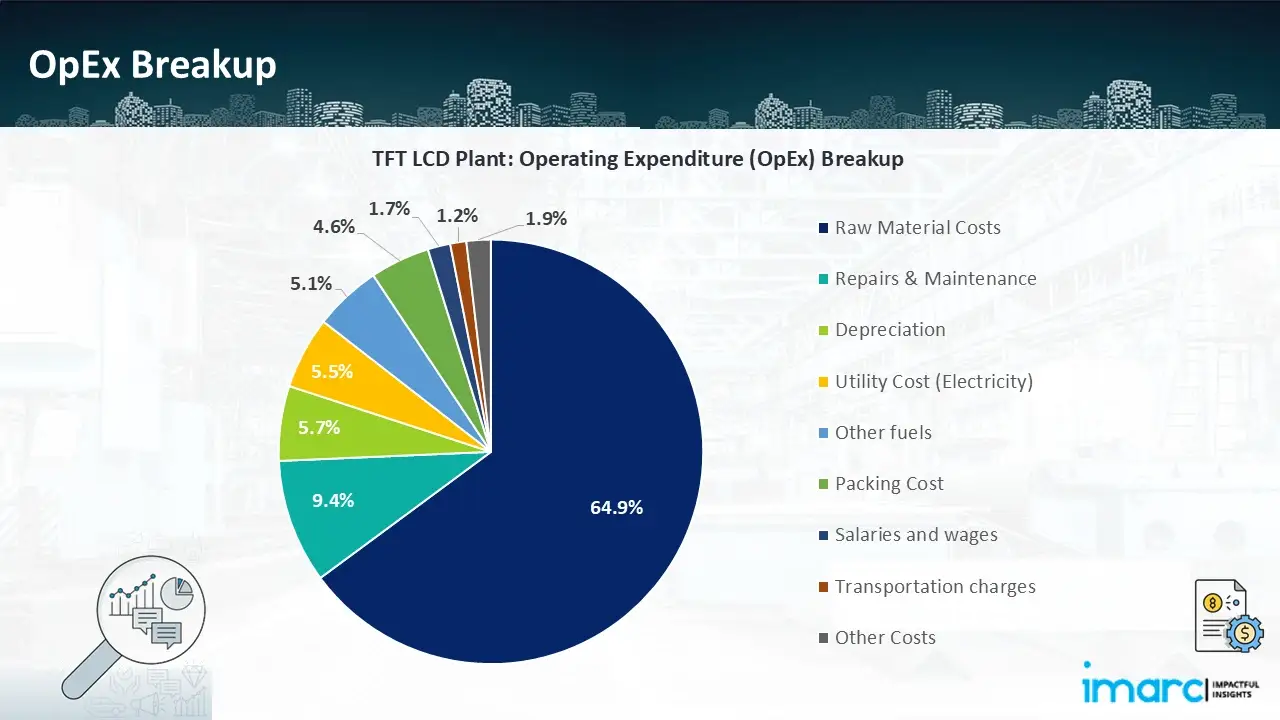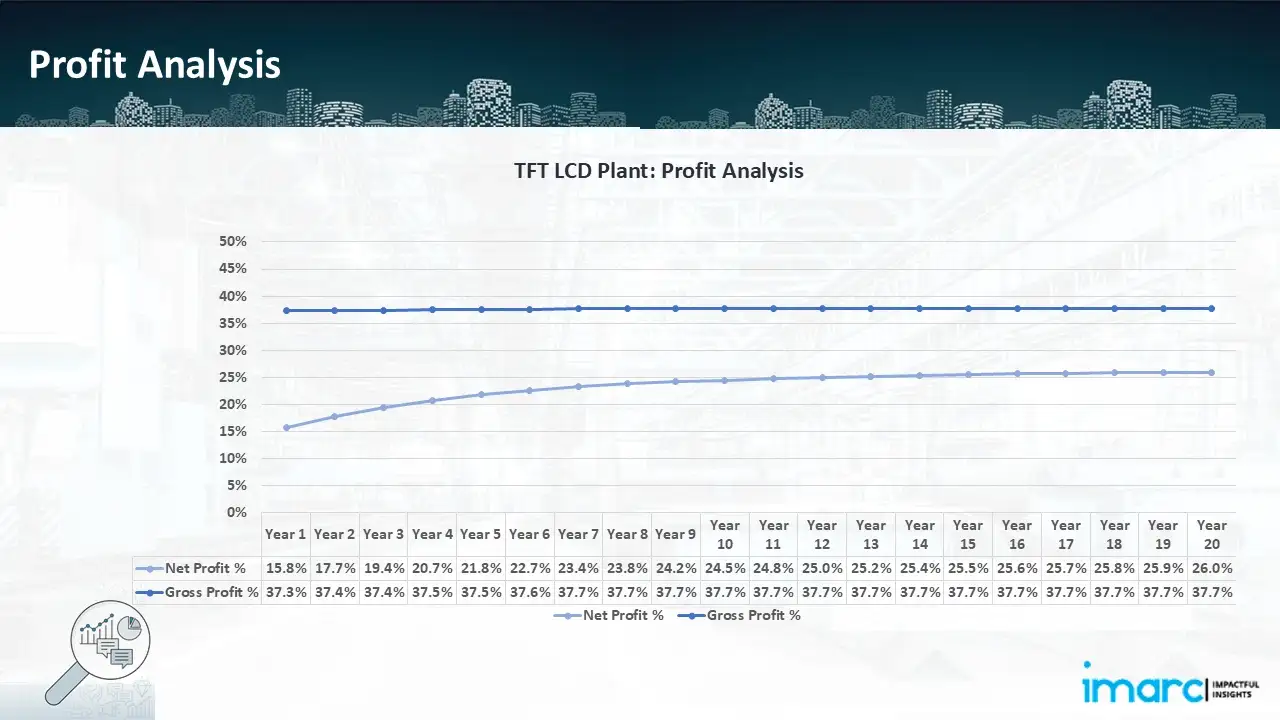Breakdown of Production Costs of TFT LCD Manufacturing Plant: A Detailed Cost Model

What is TFT LCD?
Thin-film-transistor (TFT) liquid-crystal display (LCD) is a type of display technology used in many electronic devices, such as smartphones, tablets, laptops, and televisions (TVs). A backlight, colour filters, a thin-film transistor array, and a liquid crystal layer are among the layers that make up this flat-panel display.
Key Applications Across Industries:
TFT LCDs are made to produce sharp images with superb viewing angles, strong contrast, and accurate colour reproduction. They are made up of thousands of tiny transistors that regulate how much light enters each pixel. This makes it possible for the display to generate crisp, detailed images at rapid refresh rates. TFT LCD technology's low power consumption is one of its main benefits, which makes it perfect for battery-operated gadgets.
What the Expert Says: Market Overview & Growth Drivers
According to an IMARC study, the global TFT LCD market size reached USD 179.9 Billion in 2024. Looking ahead, the market is expected to grow at a CAGR of approximately 3.98% from 2025 to 2033, reaching a projected value of USD 256.3 Billion by 2033. One of the main factors propelling the global market expansion is the rising demand for electronic devices, including TVs, laptops, tablets, and smartphones.
Accordingly, the market is expanding because of rising consumer demand for premium displays with outstanding colour accuracy, high resolution, and quick refresh rates. In addition, the market is expanding because to the growing trend of larger screens in electronic devices, particularly in the industrial and automotive industries. This can be linked to the growing demand for improved visibility and user interfaces that are easier to use. Other factors, such as advancements in TFT LCD technology, the increasing trend of digitization and automation in various industries, and rapid urbanization, coupled with rising disposable income levels and consumer expenditure capacities, are creating a positive outlook for the market.
Case Study on Cost Model of TFT LCD Manufacturing Plant:
Objective
One of our clients has approached us to conduct a feasibility study for establishing a mid to large-scale TFT LCD panels manufacturing plant in India.
IMARC Approach: Comprehensive Financial Feasibility
We have developed a detailed financial model for the plant's setup and operations with projections up to 20 years. The proposed facility is designed with a production capacity of 900,000 TFT LCD panels per year.
Manufacturing Process: Three primary steps are involved in the creation of TFT LCD panels: array, cell, and module.
A glass substrate coated with photoresist is the first step in the array stage. The panel is exposed to light through a photomask using photolithography, and then it is developed and etched to create circuit designs. After the photoresist is removed, a structured layer is left behind, which serves as the thin-film transistors' base. Accurate patterns are guaranteed by a careful examination.
The glass substrates are cleaned and ready for liquid crystal alignment during the Cell stage. To regulate the orientation of molecules, an alignment layer is placed. To maintain consistent cell thickness, spacers are introduced. The LCD cell structure is created by carefully depositing the liquid crystal material in between the glass layers, which are subsequently sealed.
In order to guarantee consistent illumination, the Module stage starts with the backlight assembly. Electrical connectivity is established through the mounting of driver integrated circuits and Flexible Printed Circuit (FPC) bonding. To confirm display performance, brightness, and response time, the assembled panel is tested and inspected. The panels are then packaged and sent to manufacturers to be incorporated into consumer gadgets including as laptops, cell phones, and televisions.

Get a Tailored Feasibility Report for Your Project Request Sample
Mass Balance and Raw Material Required: The primary raw materials utilized in the TFT LCD panel manufacturing plant include glass substrate, indium tin oxide, silicon dioxide, liquid crystals, photomask, thin film deposition material, polarizing films and backlight. To manufacture 1 unit of TFT LCD panel, we require 1.38 Meter sq. of glass substrate, 56.5 gram of indium tin oxide, 272.9 gram of silicon dioxide, 6.6 gram of liquid crystals, 1 piece of photomask, 69.6 gram of thin film deposition material, 2 piece of polarizing films and 1 piece of backlight.
List of Machinery:
The following equipment was required for the proposed plant:
- Inline Inspection Machine (Before Deposition)
- Array Tester Machine
- Deposition
- Repair for Array
- Other Array Processing Machinery
- Inline Inspection Machine
- Exposure Machine
- Color Filter Process Machinery
- Grinding Machine
- Inline Inspection Machine
- Cell Process Machinery
- Ultrapure Water Production System
- Waste Water Treatment System
- Waste Water Recycling System
Techno-Commercial Parameter:
- Capital Investment (CapEx): Capital expenditure (CapEx) in a manufacturing plant includes various investments essential for its setup and long-term operations. It covers machinery and equipment costs, including procurement, installation, and commissioning. Civil works expenses involve land development, factory construction, and infrastructure setup. Utilities such as power, water supply, and HVAC systems are also significant. Additionally, material handling systems, automation, environmental compliance, and safety measures are key components. Other expenditures include IT infrastructure, security systems, and office essentials, ensuring operational efficiency and business growth.
- Operating Expenditure (OpEx): Operating expenditure is the cost incurred to operate a manufacturing plant effectively. OpEx in a manufacturing plant typically includes the cost of raw materials, utilities, depreciation, taxes, packing cost, transportation cost, and repairs and maintenance. The operating expenses are part of the cost structure of a manufacturing plant and have a significant effect on profitability and efficiency. Effective control of these costs is necessary for maintaining competitiveness and growth.

- Profitability Analysis Year on Year Basis: The proposed TFT LCD plant, with a capacity of 900,000 units of TFT LCD panels annually, achieved an impressive revenue of USD 1,168 million in its first year. We assisted our client in developing a detailed cost model, which projects steady growth, with revenue rising till year 6 and stays constant till year 20. Moreover, gross profit improved from 37.3% to 37.7%, and net profit rise from 15.8% to 26.0%, highlighting strong financial viability and operational efficiency.

Conclusion & IMARC's Impact:
Our TFT LCD panel manufacturing plant's financial model was meticulously modelled to satisfy the client's requirements. It provided a thorough analysis of production costs including capital expenditures, manufacturing processes, raw materials, and operating costs. The model predicts profitability while accounting for market trends, inflation, and any shifts in the price of raw materials. It was created especially to satisfy the demand of producing 900,000 units of TFT LCD panels annually. Our commitment to offering precise, client-cantered solutions that ensure the long-term success of significant industrial projects by giving the client useful data for strategic decision-making is demonstrated by this comprehensive financial model.
Latest News and Developments:
- In September 2024, LG Display announced that it is selling TCL CSOT its share of its Chinese LCD facility for USD 1.5 Billion as part of its strategic move away from LCD manufacturing. While TCL CSOT solidifies its place in the global LCD industry, the agreement supports LG Display's emphasis on high-margin OLED technologies. 80% of LG Display's major LCD panel facility and 100% of its LCD module plant are being sold.
- In September 2024, Laibao announced aiming to construct a new Gen 8.6 TFT LCD fab that will manufacture MEDs, or plasma displays, and a-Si TFT LCD panels.
- In May 2024, Vedanta purchased AvanStrate for its glass substrates utilized in TFT LCD screens for numerous uses. This action supports the brand's objective of helping India become more self-reliant in the electronics sector and strengthens the company's position in the country's electronics production.
- In February 2024, Vedanta and Innolux plan to begin mass production of LCD displays in India at an anticipated cost between USD 3–4 Billion. TFT-LCD and touch sensor fabrications are owned by Innolux. It is anticipated that LCDs will dominate the market. Tower Semiconductors and Tata Group have also made proposals.
- In May 2022, HannStar Display announced that it would be establishing production lines for IGZO (indium gallium zinc oxide) TFT-LCD panels based on 5G or 6G glass substrates.
Why Choose IMARC:
IMARC's Financial Model Expertise: Helping Our Clients Explore Industry Economics
IMARC is a global market research company that offers a wide range of services, including market entry and expansion, market entry and opportunity assessment, competitive intelligence and benchmarking, procurement research, pricing and cost research, regulatory approvals and licensing, factory setup, factory auditing, company incorporation, incubation services, recruitment services, and marketing and sales.
Brief List of Our Services: Market Entry and Expansion
- Market Entry and Opportunity Assessment
- Competitive Intelligence and Benchmarking
- Procurement Research
- Pricing and Cost Research
- Sourcing
- Distribution Partner Identification
- Contract Manufacturer Identification
- Regulatory Approvals, and Licensing
- Factory Setup
- Factory Auditing
- Company Incorporation
- Incubation Services
- Recruitment Services
- Marketing and Sales
Under our factory setup services, we assist our clients in exploring the feasibility of their plants by providing comprehensive financial modeling. Additionally, we offer end-to-end consultation for setting up a plant in India or abroad. Our financial modeling includes an analysis of capital expenditure (CapEx) required to establish the manufacturing facility, covering costs such as land acquisition, building infrastructure, purchasing high-tech production equipment, and installation. Furthermore, the layout and design of the factory significantly influence operational efficiency, energy consumption, and labor productivity, all of which impact long-term operational expenditure (OpEx). So, every parameter is covered in the analysis.
At IMARC, we leverage our comprehensive market research expertise to support companies in every aspect of their business journey, from market entry and expansion to operational efficiency and innovation. By integrating our factory setup services with our deep knowledge of industry dynamics, we empower our clients to not only establish manufacturing facilities but also strategically position themselves in highly competitive markets. Our financial modeling and end-to-end consultation services ensure that clients can explore the feasibility of their plant setups while also gaining insights into competitors' strategies, technological advancements, and regulatory landscapes. This holistic approach enables our clients to make informed decisions, optimize their operations, and align with sustainable practices, ultimately driving long-term success and growth.
Our Clients
Contact Us
Have a question or need assistance?
Please complete the form with your inquiry or reach out to us at
Phone Number
+91-120-433-0800+1-201-971-6302
+44-753-714-6104











